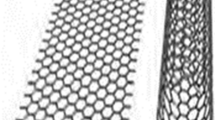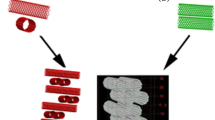Abstract
We report on the fabrication of self-organized titanium oxide nanotube arrays of enhanced surface area prepared by anodic oxidation of a pure titanium sheet in electrolyte solutions containing potassium fluoride (KF) or sodium fluoride (NaF). The effects of electrolyte composition and concentration, solution pH, and the anodic potential on the formation of nanotubes and dimensions of the resulting nanotubes are detailed. Although nanotube arrays of length greater than 500 nm are not possible with hydrofluoric acid containing electrolytes [G.K. Mor, O.K. Varghese, M. Paulose, N. Mukherjee, C.A. Grimes, J. Mater. Res. 18, 2588 (2003)], by adjusting the pH of a KF containing electrolyte to 4.5 using additives such as sulfuric acid, sodium hydroxide, sodium hydrogen sulfate, and/or citric acid, we could increase the length of the nanotube-array to approximately 4.4 μm, an order of magnitude increase in length. The as-prepared nanotubes are composed of amorphous titanium oxide. Independent of the electrolyte composition, crystallization of the nanotubes to anatase phase occurred at temperatures ≥280 °C. Rutile formation occurred at the nanotube-Ti substrate interface at temperatures near 480 °C. It appears geometry constraints imposed by the nanotube walls inhibit anatase to rutile transformation. No disintegration of the nanotube array structure is observed at temperatures as high as 580 °C. The excellent structural and crystal phase stability of these nanotubes make them promising for both low- and high-temperature applications.
Similar content being viewed by others
References
O.K. Varghese, D.W. Gong, M. Paulose, C.A. Grimes, and E.C. Dickey: Crystallization and high-temperature structural stability of titanium oxide nanotube arrays. J. Mater. Res. 18, 156 (2003).
V. Zwilling, E. Darque-Ceretti, A. Boutry-Forveille, D. David, M.Y. Perrin, and M. Aucouturier: Structure and physicochemistry of anodic oxide films on titanium and TA6V alloy. Surf. Interface Anal. 27, 629 (1999).
G.K. Mor, M.A. Carvalho, O.K. Varghese, M.V. Pishko, and C.A. Grimes: A room-temperature TiO2-nanotube hydrogen sensor able to self-clean photoactively from environmental contamination. J. Mater. Res. 19, 628 (2004).
O.K. Varghese, D. Gong, M. Paulose, K.G. Ong, and C.A. Grimes: Hydrogen sensing using titania nanotubes. Sens. Actuators B 93,338 (2003).
O.K. Varghese, D. Gong, M. Paulose, K.G. Ong, E.C. Dickey, and C.A. Grimes: Extreme changes in the electrical resistance of titania nanotubes with hydrogen exposure. Adv. Mater. 15, 624 (2003).
R. Beranek, H. Hildebrand, and P. Schmuki: Self-organized porous titanium oxide prepared in H2SO4/HF electrolytes. Electrochem. Solid State Lett. 6, B12 (2003).
G.K. Mor, O.K. Varghese, M. Paulose, N. Mukherjee, and C.A. Grimes: Fabrication of tapered, conical-shaped titania nanotubes. J. Mater. Res. 18, 2588 (2003).
B.C. Yang, M. Uchida, H.M. Kim, X.D. Zhang, and T. Kokubo: Preparation of bioactive titanium metal via anodic oxidation treatment. Biomaterials 25, 1003 (2004).
Y.T. Sul, C.B. Johansson, Y. Jeong, and T. Albrektsson: The electrochemical oxide growth behaviour on titanium in acid and alkaline electrolytes. Med. Eng. Phys. 23, 329 (2001).
D. Gong, C.A. Grimes, O.K. Varghese, W. Hu, R.S. Singh, Z. Chen, and E.C. Dickey: Titanium oxide nanotube arrays prepared by anodic oxidation. J. Mater. Res. 16, 3331 (2001).
O.K. Varghese, G.K. Mor, C.A. Grimes, M. Paulose, and N. Mukherjee: A titania nanotube-array room-temperature sensor for selective detection of hydrogen at low concentrations. J. Nanosci. Nanotech. 4, 733 (2004).
M. Adachi, Y. Murata, I. Okada, and S. Yoshikawa: Formation of titania nanotubes and applications for dye-sensitized solar cells. J. Electrochem. Soc. 150, G488 (2003).
G. Giavaresi, R. Giardino, L. Ambrosio, G. Battiston, R. Gerbasi, M. Fini, L. Rimondini, and R. Torricelli: In vitro biocompatibility of titanium oxide for prosthetic devices nanostructured by low pressure metal-organic chemical vapor deposition. Int. J. Artif. Organs 26, 774 (2003).
H.D. Jang, S.K. Kim, and S.J. Kim: Effect of particle size and phase composition of titanium dioxide nanoparticles on the photocatalytic properties. J. Nanopart. Res. 3, 141 (2001).
R. Rodriguez, K. Kim, and J.L. Ong: In vitro osteoblast response to anodized titanium and anodized titanium followed by hydrothermal treatment. J. Biomed. Mater. Res. A 65, 352 (2003).
O. Zinger, P.F. Chauvy, and D. Landolt: Scale-resolved electrochemical surface structuring of titanium for biological applications. J. Electrochem. Soc. 150, B495 (2003).
P.I. Gouma and M.J. Mills: Anatase-to-rutile transformation in titania powders. J. Am. Ceram. Soc. 84, 619 (2001).
H. Zhang and J.F. Banfield: Phase transformation of nanocrystalline anatase-to-rutile via combined interface and surface nucleation. J. Mater. Res. 15, 437 (2000).
K-N.P. Kumar, K. Keizer, A.J. Burggraaf, T. Okubo, and H. Nagamoto: Textural evolution and phase transformation in titania mmbranes: Part 2. Supported membranes. J. Mater. Chem. 3, 1151 (1993).
Y. Ohya, H. Saiki, T. Tanaka, and Y. Takahashi: Microstructure of TiO2 and ZnO films fabricated by sol-gel method. J. Am. Ceram. Soc. 79, 825 (1996).
M.R. Hoffmann, S.T. Martin, W. Choi, and D.W. Bahnemannt: Environmental applications of semiconductor photcatalysis. Chem. Rev. 95, 69 (1995).
M.A. Fox and M.T. Dulay: Heterogeneous photocatalysis. Chem. Rev. 93, 341 (1993).
M. Gratzel: Photoelectrochemical cells. Nature 414, 338 (2001).
Author information
Authors and Affiliations
Corresponding author
Rights and permissions
About this article
Cite this article
Cai, Q., Paulose, M., Grimes, C.A. et al. The effect of electrolyte composition on the fabrication of self-organized titanium oxide nanotube arrays by anodic oxidation. Journal of Materials Research 20, 230–236 (2005). https://doi.org/10.1557/JMR.2005.0020
Received:
Accepted:
Published:
Issue Date:
DOI: https://doi.org/10.1557/JMR.2005.0020




